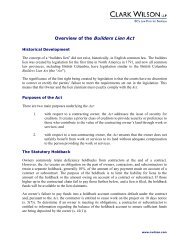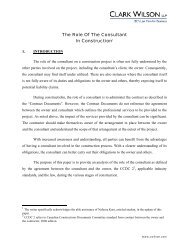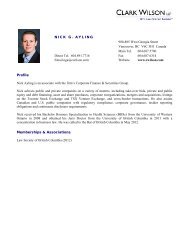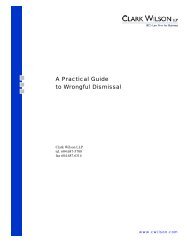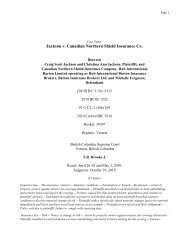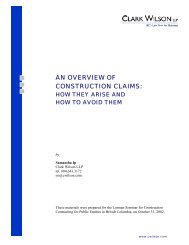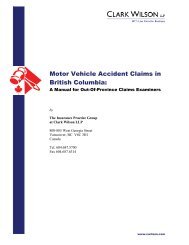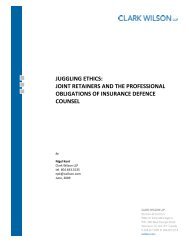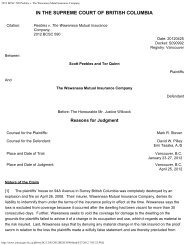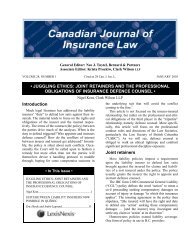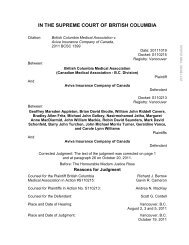Create successful ePaper yourself
Turn your PDF publications into a flip-book with our unique Google optimized e-Paper software.
Kruger Products Limited v. First Choice Logistics Inc. Page 14<br />
not “inside” or is external to the engine compartment itself. It seems to me that<br />
para. 56 of Scott’s factum aptly describes the reasoning adopted by the trial judge:<br />
Since the evidence at trial was clear that: (i) the actual strip of paper that<br />
caused the Fire was somehow attached to the exhaust grill; (ii) all other<br />
possible sources for the ignition of the Fire other than the [Forklift] were<br />
eliminated by the Appellant; (iii) the unwrapped exhaust pipes were known to<br />
be hot enough to start paper fires; and (iv) paper cannot escape from inside<br />
the engine compartment, it must be that the Fire started by paper touching<br />
that part of the exposed exhaust pipe near the muffler at the back of the<br />
[Forklift].<br />
[27] As Scott notes, this explanation is consistent with Mr. Bodnar’s experience<br />
with the Original Forklift described above. It is also consistent with the discovery<br />
evidence of Mr. Woykin, another FCL employee who worked in the warehouse. He<br />
recalled that before the exhaust system of the Original Forklift was “wrapped”, he<br />
had seen paper “smouldering” with smoke coming from a location under the driver’s<br />
seat of the machine, which was then being operated by a Mr. Bertie. By the time he<br />
and Mr. Bertie located an operating fire extinguisher, Mr. Woykin could see flames.<br />
2013 BCCA 3 (CanLII)<br />
[28] Significant evidence in this regard was also given by a Mr. Reinders, an<br />
employee of Toyota Canada Inc. He recalled “problems” experienced by Toyota<br />
early on in the production of its GM262 engines – the kind used in the Original<br />
Forklift and the Forklift. According to his testimony, these machines had a<br />
“propensity to suck up paper into the engine compartment and through into the<br />
radiator”, and to overheat. These problems were experienced where the units were<br />
“working extremely hard in the environment where there is significant debris on the<br />
floor that leads to plugging of the rads, and there is a ... very heavy use of the<br />
attachments that are on the truck.” The witness was referred to an internal Toyota<br />
memorandum to Toyota Canada describing overheating in pulp and paper<br />
applications of the machine. Toyota Canada recommended the following measures<br />
in response:<br />
1) Increase size of engine pipe diameter to allow for easier exhaust flow.<br />
2) Improved air flow around exhaust pipe to remove excess heat.<br />
3) Add fibreglass insulation wrap to engine pipe.<br />
4) Reduce hydraulic pressure, thus lowering hydraulic load on engine.




